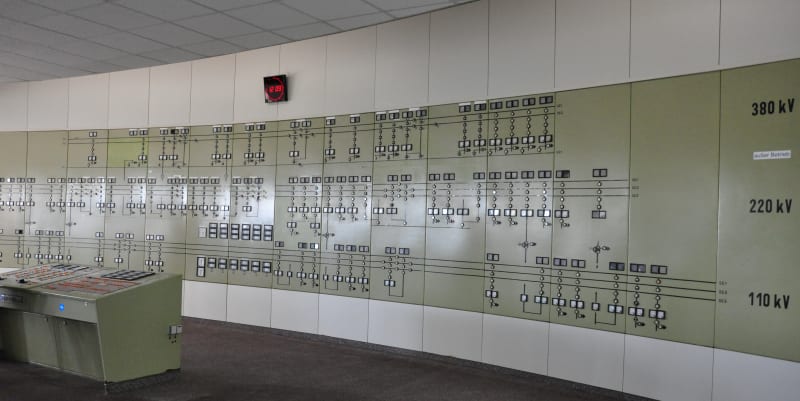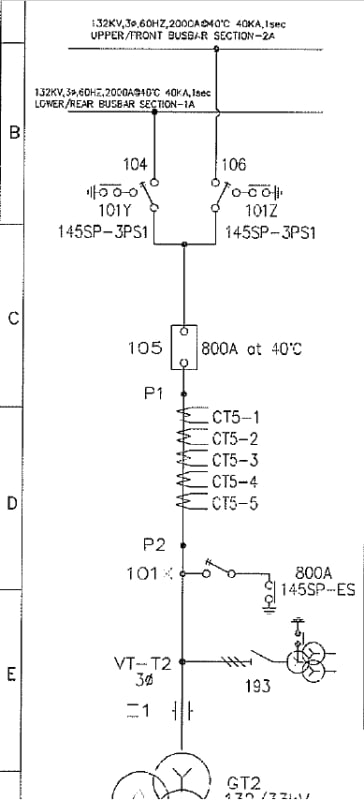Navigation
Install the app
How to install the app on iOS
Follow along with the video below to see how to install our site as a web app on your home screen.
Note: This feature may not be available in some browsers.
More options
Style variation
-
Congratulations MintJulep on being selected by the Eng-Tips community for having the most helpful posts in the forums last week. Way to Go!
You are using an out of date browser. It may not display this or other websites correctly.
You should upgrade or use an alternative browser.
You should upgrade or use an alternative browser.
Device Interlocking Necessary?
- Thread starter Mbrooke
- Start date
- Status
- Not open for further replies.
thermionic1
Electrical
Our crews work exclusively from switching orders. Many Maintenance or Troubleshooters have printers in their trucks, else they call in and write down the orders in a log book. If there are MOD's involved with SCADA control, interlocking exists to prevent opening / closing a switch under load. All of the switching orders are executed with 3 way communication between dispatch and the field. A Switchman may carry out a series of instructions and call dispatch with a record of their times for each step.
- Thread starter
- #3
bacon4life
Electrical
Just because an order is written down, does not mean that the written order is error free. Nor does it guarantee that the crew will never make a mistake while following the written order. Physical interlocks are another layer of protection against certain kinds of switching actions. The most common interlock we use is that grounding switches are often interlocked with isolation switches.
- Thread starter
- #5
mbrooke wrote:
It's not that way in any control room I ever worked in . . .
Like bacon said, errors can be made in preparing and checking switching plans and orders, therefore it is very unwise to place reliance on administrative controls . . . and when it comes to interlocks I too would much prefer the hard-wired variety over the digital.
At several of our high voltage [115, 230 and 500 kV] stations where gas insulated switchgear is used we employ a Switchgear Interlock System, the type of which I am uncertain . . . but one of the interesting features of this system is the Interlock Bypass Facility. The primary use of this interlock bypass capability is to isolate circuit breakers that are both annunciating for low insulating gas, or loss of hydraulic pressure, or loss of accumulator cushion gas, and have simultaneously become inoperable. In such situations the operators/system controllers will [a] promptly confirm a galvanically closed loop from one side of said breaker's disconnect switches around through other "diameters" and on to the other side of the stuck breaker, invoke the Interlock Bypass, [c] open the disconnects on either side of the stuck breaker, then retire Bypass interlock.
Absent this capability, we would have to follow specified switching procedures and written instructions taking all required steps to completely remove [I know, I know, split infinitive] the stuck breaker from potential, which could include precipitously forcing 850 MVA nuclear generators off line, the adverse economic spin-offs of which could be quite significant.
Our IESO really likes this feature, as "re-preparation time" [NERC terminology] following this contingency is almost invariably less than the required thirty minutes.
CR
"As iron sharpens iron, so one person sharpens another." [Proverbs 27:17, NIV]
I take [it] that in the control house there is unhindered control of all devices?
It's not that way in any control room I ever worked in . . .
Like bacon said, errors can be made in preparing and checking switching plans and orders, therefore it is very unwise to place reliance on administrative controls . . . and when it comes to interlocks I too would much prefer the hard-wired variety over the digital.
At several of our high voltage [115, 230 and 500 kV] stations where gas insulated switchgear is used we employ a Switchgear Interlock System, the type of which I am uncertain . . . but one of the interesting features of this system is the Interlock Bypass Facility. The primary use of this interlock bypass capability is to isolate circuit breakers that are both annunciating for low insulating gas, or loss of hydraulic pressure, or loss of accumulator cushion gas, and have simultaneously become inoperable. In such situations the operators/system controllers will [a] promptly confirm a galvanically closed loop from one side of said breaker's disconnect switches around through other "diameters" and on to the other side of the stuck breaker, invoke the Interlock Bypass, [c] open the disconnects on either side of the stuck breaker, then retire Bypass interlock.
Absent this capability, we would have to follow specified switching procedures and written instructions taking all required steps to completely remove [I know, I know, split infinitive] the stuck breaker from potential, which could include precipitously forcing 850 MVA nuclear generators off line, the adverse economic spin-offs of which could be quite significant.
Our IESO really likes this feature, as "re-preparation time" [NERC terminology] following this contingency is almost invariably less than the required thirty minutes.
CR
"As iron sharpens iron, so one person sharpens another." [Proverbs 27:17, NIV]
- Thread starter
- #7
@CRshears: I think know what you are refering to. I know of designs that have a key switch. Normally workers can not perform any switching outside of what interlocking allows, but with the approval of a supervising engineer a key can be inserted which will remove all interlocks. This is used like you say under emergency conditions or some failure of the aux switches which are giving a position/indication that does not reflect reality. For example a breaker is open, isolated and a ground switch needs to be closed but a bad aux switch is saying the breaker is closed. In that case over-riding of all interlocking logic is a must.
The thing that making me want to not have any logic is the amount of wiring and aux relays that are involved with it. I know, not a good excuse but it sure is tempting.
The thing that making me want to not have any logic is the amount of wiring and aux relays that are involved with it. I know, not a good excuse but it sure is tempting.
- Thread starter
- #9
thermionic1
Electrical
And not all interlocks are the same. A few years ago I was commissioning the protection on a 500kV 3 breaker ring bus. Each breaker disconnect was a combination Disconnect Switch / Ground Switch (DS/GS). The DS/GS had a mechanical interlock. I looked into the controls and noticed that it was only a mechanical interlock. I asked the questions about the lack of electrical interlock between the motor operated DS & GS. I was told it was not necessary.
The crew setting up and testing these switches inadvertently found a way to electrically operate the switch while interlocked and destroyed the mechanical interlock. Shortly thereafter, we were designing and installing an electrical interlock for the switches. Fortunately this was all during commissioning and no real harm was caused.
I just finished up commissioning a 5 bay GIS ring. All switches, ground switches and breakers were electrically interlocked. The switches themselves had mechanical interlocks that would not allow manual operation of the devices without the electrical interlocking being satisfied. For these types of systems, with all of the switches and grounding switches being motor operated, I believe it is imperative to have said interlocks installed. In this case, only the breakers had SCADA control.
I believe if it's motor operated and certainly if it can be operated remotely, an interlock system should be installed. In an AIS station with mostly manually operated switches, in a utility environment, this is not always done. A lot of utilities don't utilize ground switches and rely on hanging grounds, after checking for lack of potential.
The crew setting up and testing these switches inadvertently found a way to electrically operate the switch while interlocked and destroyed the mechanical interlock. Shortly thereafter, we were designing and installing an electrical interlock for the switches. Fortunately this was all during commissioning and no real harm was caused.
I just finished up commissioning a 5 bay GIS ring. All switches, ground switches and breakers were electrically interlocked. The switches themselves had mechanical interlocks that would not allow manual operation of the devices without the electrical interlocking being satisfied. For these types of systems, with all of the switches and grounding switches being motor operated, I believe it is imperative to have said interlocks installed. In this case, only the breakers had SCADA control.
I believe if it's motor operated and certainly if it can be operated remotely, an interlock system should be installed. In an AIS station with mostly manually operated switches, in a utility environment, this is not always done. A lot of utilities don't utilize ground switches and rely on hanging grounds, after checking for lack of potential.
Wrinkle: in GIS installations, mechanical interlocks between breaker disconnects and the "inside" grounds would be very problematic, as our electrical maintenance crews routinely remove the ground links from one of the inside ground switches to provide an access point for breaker timing tests, with the next bus section on that side of the breaker also isolated and grounded. By this means the now-ungrounded side of the open breaker can readily be grounded whenever desired by closing that breaker disconnect utilizing grounding continuity.
[URL unfurl="true"]https://res.cloudinary.com/engineering-com/image/upload/v1606496395/tips/Typical_HVGIS_Work_Zone_cpcdab.bmp[/url]
Mechanical interlocks would prevent closure of the breaker disconnect on that side with the ground switch closed and render equipment grounding by this means impossible.
BTW what's the trick to embedding an image into a post the way Mbrooke did?
[URL unfurl="true"]https://res.cloudinary.com/engineering-com/image/upload/v1606496395/tips/Typical_HVGIS_Work_Zone_cpcdab.bmp[/url]
Mechanical interlocks would prevent closure of the breaker disconnect on that side with the ground switch closed and render equipment grounding by this means impossible.
BTW what's the trick to embedding an image into a post the way Mbrooke did?
- Thread starter
- #13
Look for the camera/image icon above the "Submit Post" button. Click it, chose an ifranview image from your computer (I'm guessing it works for any jpg) than hit "open" and a worded link should appear in the type space.

Regarding interlocking I'd never go mechanical in a utility sub AIS or GIS, simply electric or electronic for the reasons mentioned above. The exception would be kirk keys and lock-out tag out.
From the sounds of it I need either electric or electronic interlocks regardless. Despite the migraine in interlocking a station along the lines of this, which as you guess makes me want to "keep things simple":

Regarding interlocking I'd never go mechanical in a utility sub AIS or GIS, simply electric or electronic for the reasons mentioned above. The exception would be kirk keys and lock-out tag out.
From the sounds of it I need either electric or electronic interlocks regardless. Despite the migraine in interlocking a station along the lines of this, which as you guess makes me want to "keep things simple":

- Thread starter
- #15
- Moderator
- #16
Go to the picture.
Right click on the picture.
From the drop down box select "Copy Image"
This will save the image to your clip board.
Now click on the image icon in Eng-Tips.
Cntrl V to paste the picture.
Bill
--------------------
"Why not the best?"
Jimmy Carter
Right click on the picture.
From the drop down box select "Copy Image"
This will save the image to your clip board.
Now click on the image icon in Eng-Tips.
Cntrl V to paste the picture.
Bill
--------------------
"Why not the best?"
Jimmy Carter
- Status
- Not open for further replies.
Similar threads
- Locked
- Question
- Replies
- 13
- Views
- 4K
- Locked
- Question
- Replies
- 10
- Views
- 1K
- Locked
- Question
- Replies
- 5
- Views
- 741
- Locked
- Question
- Replies
- 2
- Views
- 2K
- Replies
- 0
- Views
- 127


![[tongue] [tongue] [tongue]](/data/assets/smilies/tongue.gif)